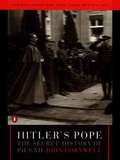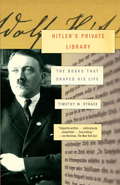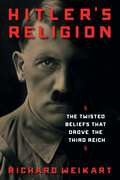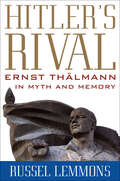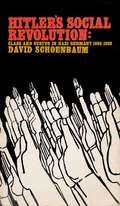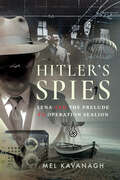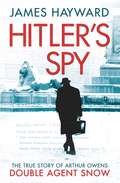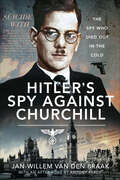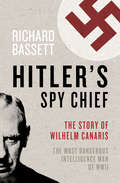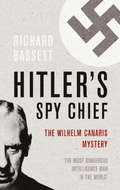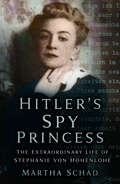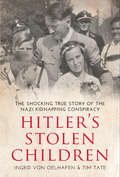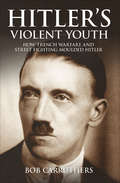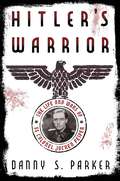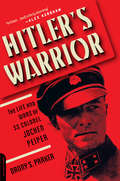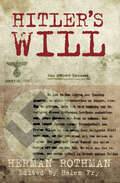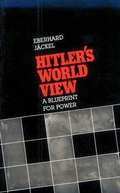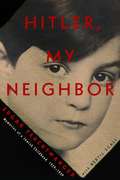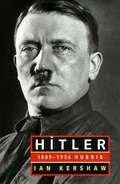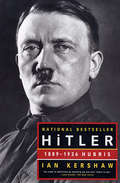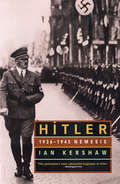- Table View
- List View
Hitler's Pope: The Secret History of Pius XII
by John CornwellThe "explosive" (The New York Times) bestseller-now with a new introduction by the author <P> When Hitler's Pope, the shocking story of Pope Pius XII that "redefined the history of the twentieth century" (The Washington Post ) was originally published, it sparked a firestorm of controversy both inside and outside the Catholic Church. Now, award-winning journalist John Cornwell has revisited this seminal work of history with a new introduction that both answers his critics and reaffirms his overall thesis that Pius XII, now scheduled to be canonized by the Vatican, weakened the Catholic Church with his endorsement of Hitler-and sealed the fate of the Jews in Europe.
Hitler's Priestess
by Nicholas Goodrick-ClarkeIn this window onto the roots and evolution of international neo-Nazism, Nicholas Goodrick-Clarke reveals the powerful impact of one of fascism's most creative minds. Savitri Devi's influence on neo-Nazism and other hybrid strains of mystical fascism has been continuos since the mid-1960s. A Frenchwoman of Greek-English birth, Devi became an admirer of German National Socialism in the late 1920s. Deeply impressed by its racial heritage and caste-system, she emigrated to India, where she developed her racial ideology, in the early 1930s. Her works have been reissued and distributed through various neo-Nazi networks and she has been lionized as a foremother of Nazi ideology. Her appeal to neo-Nazi sects lies in the very eccentricity of her thought - combining Aryan supremacism and anti-Semitism with Hinduism, social Darwinisn, animal rights, and a fundamentally biocentric view of life - and has resulted in curious, yet potent alliances in radical ideology. As one of the earliest Holocaust deniers and the first to suggest that Adolf Hitler was an avatar-- a god come to earth in human form to restore the world to a golden age - Devi became a fixture in the shadowy neo-Nazi world. In Hitler's Priestess, Nicholas Goodrick-Clarke examines how someone with so little tangible connection to Nazi Germany became such a powerful advocate of Hitler's misanthropy. Hitler's Priestess illuminates the life of a woman who achieved the status of a prophetess for her penchant for redirecting authentic religious energies in the service of regenerate fascism.
Hitler's Private Library: The Books That Shaped His Life
by Timothy W. RybackHe was, of course, a man better known for burning books than collecting them and yet by the time he died, aged 56, Adolf Hitler owned an estimated 16,000 volumes -- the works of historians, philosophers, poets, playwrights and novelists. A passionate reader, his worldview was largely formed by the books he read. For more than fifty years the remnants of Hitler's private library occupied shelf-space in climate-controlled obscurity in the rare book division of the Library of Congress in Washington. Timothy Ryback is the first to systematically explore this remarkable collection, as well as several other caches which he subsequently discovered in Europe and elsewhere. The volumes in Hitler's library are fascinating in themselves but it is the marginalia -- the comments, the exclamation marks, the questions and underlinings, even the dirty thumbprints on the pages of a book he read in the trenches of the First World War -- which are so revealing. Together they take us closer to the man and his thinking than ever seemed possible. Hitler's Private Library provides us with a remarkable view of Hitler's evolution u and unparalleled insights into his emotional and intellectual world. Utterly compelling, it is also a landmark in our understanding of the Third Reich.
Hitler's Religion: The Twisted Beliefs that Drove the Third Reich
by Richard WeikartFor a man whom history can never forget, Adolf Hitler remains a persistent mystery on one front-his religious faith. Atheists tend to insist Hitler was a devout Christian. Christians counter that he was an atheist. And still others suggest that he was a practicing member of the occult. <P><P>None of these theories are true, says historian Richard Weikart. Delving more deeply into the question of Hitler's religious faith than any researcher to date, Weikart reveals the startling and fascinating truth about the most hated man of the 20th century: Adolf Hitler was a pantheist who believed nature was God. <P><P>In Hitler's Religion, Weikart explains how the laws of nature became Hitler's only moral guide-how he became convinced he would serve God by annihilating supposedly "inferior" human beings and promoting the welfare and reproduction of the allegedly superior Aryans in accordance with racist forms of Darwinism prevalent at the time.
Hitler's Rival: Ernst Thälmann in Myth and Memory
by Russel Lemmons“Fascinating material . . . This book will likely be the last word and the standard work on the Thälmann myth and its role in East German history.” —Catherine Epstein, author of Nazi Germany: Confronting the MythsThroughout the 1920s, German politician and activist Ernst Thälmann (1886–1944) was the leader of the largest Communist Party organization outside the Soviet Union. Thälmann was the most prominent left-wing politician in the country’s 1932 election and ran third in the presidential race after Hitler and von Hindenberg. After the Nazi Party’s victory in that contest, he was imprisoned and held in solitary confinement for eleven years before being executed at Buchenwald concentration camp in 1944 under the Führer’s direct orders.Hitler’s Rival examines how the Communist Party gradually transformed Thälmann into a fallen mythic hero, building a cult that became one of their most important propaganda tools in central Europe. Author Russel Lemmons analyzes the party intelligentsia’s methods, demonstrating how they used various media to manipulate public memory and exploring the surprising ways in which they incorporated Christian themes into their messages. Examining the facts as well as the propaganda, this unique volume separates the intriguing true biography of the cult figure from the fantastic myth that was created around him.“Lemmons analyzes in great detail the myth and legend that formed around Ernst Thälmann, who became the leader of the German Communist Party in 1925 and was a dominant politician in Weimar Germany until imprisoned by the Nazis in 1933. This comprehensive study, which treats the years before the war ended for the first time, is thoroughly researched and well written; it will be a standard work on the subject.” —G. P. Blum, Professor Emeritus, University of the Pacific
Hitler's Social Revolution: Class and Status in Nazi Germany 1933-1939
by David SchoenbaumBeginning with Germany's social situation after World War I, David Schoenbaum shows how Hitler improvised a program that apparently offered something to everyone--above all, the mirage of a classless society. In fact, the gap between the ideology of the Reich and its actual character was enormous. But under the spell of the mirage, the will to resist was undermined by an accelerating process of social disintegration.
Hitler's Spies: Lena and the Prelude to Operation Sealion
by Mel KavanaghThe incredible true story of the first four Nazi spies to infiltrate British soil is revealed in this WWII history.After the swift takeover of France and the Low Countries, Nazi Germany was on the crest of a wave. Only the United Kingdom stood in its way. Hitler quickly devised plans for the invasion of England, codenamed Operation Sealion. To lay the groundwork, a team of spies would be sent in advance to act as pathfinders for the incoming forces. Codenamed Operation Lena, this phase of the plan was considered a suicide mission by German military intelligence. They had only thirty days to recruit and train agents who had a less than convincing grasp of English language or customs. Hitler’s Spies revels the story of the first four agents to arrive on English soil—collectively known by MI5 as “The Brussels Four.”Using a wealth of primary materials, including newly declassified sources, Mel Kavanagh sheds light on one of the most audacious yet little-known operations of the Second World War, in which undertrained men were sent behind enemy lines at a time when Britain was gripped by spy paranoia.
Hitler's Spy
by James HaywardOriginally published as Double Agent Snow, Hitler's Spy is the paperback edition, which tells of how on the eve of the outbreak of the Second World War the double-agent Arthur Owens, codenamed SNOW, is summoned to Berlin and appointed Hitler's chief spy in Britain. Days later he finds himself in Wandsworth prison, betrayed by the wife he traded for a younger model, and forced to transmit false wireless messages for MI5 to earn his freedom - and avoid the hangman's noose. A vain and devious anti-hero with no moral compass, Owen's motives were status, money and women. He mixed fact with fiction constantly, and at times insisted that he was a true patriot, undertaking hazardous secret missions for his mother country; at other times, Owens saw himself as a daring rogue agent, outwitting British Intelligence and loyal only to the Fatherland. Yet in 1944, as Allied troops stormed the beaches of Normandy on D-Day, Hitler was caught unawares, tricked into expecting the invasion across the Pas de Calais in a strategic deception played out by Owens and the double-cross agents of MI5. For all his flaws, Agent Snow became the traitor who saved his country. Based on recently de-classified MI5 files and previously unpublished sources, Hitler's Spy is the story of a secret Battle of Britain, fought by Snow and his opposing spymasters, Thomas 'Tar' Robertson of MI5 and Nikolaus Ritter of the Abwehr, as well as the tragic love triangle between Owens, his wife Irene, and his mistress Lily Funnell. The evocative, fast-paced narrative moves from seedy south London pubs to North Sea trawlers, from chic Baltic spa resorts to Dartmoor gaol, populated by a colourful rogue's gallery of double-cross agents.
Hitler's Spy Against Churchill: The Spy Who Died Out in the Cold
by Jan-Willem van den BraakFrom the summer of 1940 until May 1941, nearly twenty German Abwehr agents were dropped by boat or parachute into England during what was known as Operation Lena, all in preparation for Hitler's planned invasion of England. The invasion itself would never happen and in fact, after the war, one of the Abwehr commanders declared that the operation was doomed to failure. There is no doubt that the operation did indeed become a fiasco, with almost all of the officers being arrested within a very brief period of time. Some of the men were executed, while others became double agents and spied for Britain against Germany. Only one man managed to stay at large for five months before eventually committing suicide: Jan Willem Ter Braak. Amazingly, his background and objectives had always remained unclear, and none of the other Lena spies had ever even heard of him. Even after the opening of the secret service files in England and the Netherlands over 50 years later, Jan Willem Ter Braak remained a 'mystery man', as the military historian Ladislas Farago famously described him. In this book, the author – his near-namesake – examines the short and tragic life of Jan Willem Ter Braak for the first time. Using in-depth research, he investigates the possibility that Ter Braak was sent to kill the British Prime Minister Winston Churchill and discovers why his fate has remained largely unknown for so long.
Hitler's Spy Chief: The Wilhelm Canaris Mystery
by Richard BassettA remarkable tale of espionage and intrigue--the true story of Wilhelm Canaris, Hitler's intelligence chief, and his role in the conspiracy to assassinate the Führer Admiral Wilhelm Canaris was appointed by Hitler to head the Abwehr (the German secret service) eighteen months after the Nazis came to power. But Canaris turned against the Fu¨hrer and the Nazi regime, believing that Hitler would start a war Germany could not win. In 1938 he was involved in an attempted coup, undermined by British Prime Minister Neville Chamberlain. In 1940 he sabotaged the German plan to invade England, and fed General Franco vital information that helped him keep Spain out of the war. For years he played a dangerous double game, desperately trying to keep one step ahead of the Gestapo. The SS chief, Heinrich Himmler, became suspicious of Canaris and by 1944, when Abwehr personnel were involved in the attempted assassination of Hitler, he had the evidence to arrest Canaris himself. Canaris was executed a few weeks before the end of the war. In a riveting true story of intrigue and espionage, Richard Bassett reveals how Admiral Canaris's secret work against the German leadership changed the course of World War II.
Hitler's Spy Chief: The Wilhelm Canaris Mystery
by Richard BassettHow Hitler's spy chief sabotaged the German war effort.Wilhelm Canaris was appointed by Hitler to head the Abwehr (the German secret service) 18 months after the Nazis came to power. But Canaris turned against the Fuhrer and the Nazi regime, believing that Hitler would start a war Germany could not win. In 1938 he was involved in an attempted coup, undermined by British Prime Minister Neville Chamberlain. In 1940 he sabotaged the German plan to invade England, and fed General Franco vital information that helped him keep Spain out of the war. For years he played a dangerous double game, desperately trying to keep one step ahead of the Gestapo. The SS chief, Heinrich Himmler, became suspicious of the Abwehr and by 1944, when Abwehr personnel were involved in the attempted assassination of Hitler, he had the evidence to arrest Canaris himself. Canaris was executed a few weeks before the end of the war.
Hitler's Spy Chief: The Wilhelm Canaris Mystery
by Richard BassettHow Hitler's spy chief sabotaged the German war effort.Wilhelm Canaris was appointed by Hitler to head the Abwehr (the German secret service) 18 months after the Nazis came to power. But Canaris turned against the Fuhrer and the Nazi regime, believing that Hitler would start a war Germany could not win. In 1938 he was involved in an attempted coup, undermined by British Prime Minister Neville Chamberlain. In 1940 he sabotaged the German plan to invade England, and fed General Franco vital information that helped him keep Spain out of the war. For years he played a dangerous double game, desperately trying to keep one step ahead of the Gestapo. The SS chief, Heinrich Himmler, became suspicious of the Abwehr and by 1944, when Abwehr personnel were involved in the attempted assassination of Hitler, he had the evidence to arrest Canaris himself. Canaris was executed a few weeks before the end of the war.
Hitler's Spy Princess: The Extraordinary Life of Stephanie von Hohenlohe
by Martha Schad‘Hold on to this letter, so that it will be evidence of how accurately I have kept you informed. I’m serious; don’t throw this letter away.’BORN the illegitimate daughter of Jewish parents, Princess Stephanie von Hohenlohe would rise to dizzying heights in international politics, hobnobbing with European royalty, British aristocracy – and high-ranking Nazis. She was the unofficial go-between for some of the most important people of the era, conveying secret messages and organising meetings between Adolf Hitler, Lord Rothermere, the Duke and Duchess of Windsor and more than one US president. She would even be one of only a handful of women to be awarded the Nazi Party’s Gold Medal for ‘outstanding service to the National Socialist movement’.But then the Second World War began, and everything changed.Hitler’s Spy Princess is a tale of lovers and manipulation, cleverness and deceit in the remarkable life of the woman Hitler called his ‘dear princess’.
Hitler's Stolen Children: The Shocking True Story of the Nazi Kidnapping Conspiracy
by Tim Tate Ingrid von OelhafenHitler’s Stolen Children is a powerful, first-person account of being at the heart of one of the Nazi’s cruelest and most obscene experiments—the Lebensborn program to create a new Aryan master race. In 1942, when she was nine months old, Erika Matko was stolen from her family in St. Sauerbrunn in what was then Yugoslavia and transported to Germany to be “Germanized.” She was chosen because, unlike her older brother and sister, she was blond and blue eyed, and had passed a medical racial examination that classed her as Aryan. Lebensborn then farmed her out to politically vetted German foster parents. Renamed Ingrid von Oelhafen, she grew up believing she was German. Then, one day, friends of her foster family revealed the truth about her origins. This was the beginning of a life-long quest to discover the truth about her birth and the Lebensborn program. It was a journey that would take her across Germany, uncovering the terrible secrets of Lebensborn—including the kidnapping of up to half a million babies like her and the deliberate murder of those deemed “sub-standard”—and back to the village where she was born. But here she would be faced with something even more painful: a woman who for more than seventy years had been using her name—and living her life.
Hitler's Violent Youth: How Trench Warfare and Street Fighting Moulded Hitler
by Bob CarruthersAn Emmy Award–winning author and historian delves into the brutal early life of the man who would become Nazi Germany&’s maniacal dictator. Between 1889 and 1924, Adolph Hitler&’s political outlook was borne out of vicious incidents that heralded the formation of the Sturmabteilung—the notorious SA. Drawing extensively on Hitler&’s own biographical account in Mein Kampf, Bob Carruthers illustrates how these events influenced the future führer&’s worldview and led directly to the Beer Hall Putsch of 1923. Hitler&’s difficult relationship with his cruel father, his harsh experiences in Vienna, and his involvement in the Great War all conditioned him to celebrate violent acts. By Hitler&’s own account, his complete disregard for the consequences of his actions was vindicated by his victories in fierce encounters including beer hall brawls and street battles. Each successive triumph over adversity influenced his decision-making process, imbuing him with a love of violence and culminating in the ill-fated events of November 1924, which saw Hitler imprisoned for the second time. Carruthers also explores the parallel growth of the SA from a small group of fist fighters to a feared paramilitary force along with a comprehensive survey of the violent events between 1920 and 1924, which shaped this infamous political instrument of terror alongside the man who instigated World War II.
Hitler's Warrior
by Danny S. ParkerFrom a leading expert, a definitive biography of the fearsome and controversial German SS tank commander of "Hitler’s Own” Panzer Division
Hitler's Warrior
by Danny S. ParkerFrom a leading expert, a definitive biography of the fearsome and controversial German SS tank commander of "Hitler’s Own” Panzer Division
Hitler's Warrior: The Life and Wars of SS Colonel Jochen Peiper
by Danny S. ParkerFrom a leading expert, a definitive biography of the fearsome and controversial German SS tank commander of "Hitler's Own" Panzer Division
Hitler's Warrior: The Life and Wars of SS Colonel Jochen Peiper
by Danny S. ParkerFrom a leading expert, a definitive biography of the fearsome and controversial German SS tank commander of "Hitler’s Own” Panzer Division
Hitler's Will
by Helen Fry Herman RothmanHerman Rothman arrived in Britain from Germany as a Jewish refugee in 1939, on the eve of the Second World War. He volunteered for HM Forces, serving in the Intelligence Corps, and in 1945 was posted to Westertimke and Fallingbostel prisoner of war camps to interrogate high-ranking Nazi war criminals. When papers were discovered sewn into the shoulders of a jacket belonging to Heinz Lorenz, who had been Joseph Goebbels' press secretary, he and a team of four others were charged with translating them under conditions of the deepest secrecy. The documents turned out to be the originals of Hitler's personal and political wills, and Goebbels' addendum. Later, in Rotenburg hospital, Rothman interrogated Hermann Karnau, who had been a police guard in Hitler's bunker, to establish informaiton about the Fuhrer's death. 'Hitler's Will' is the amazing true story of Herman Rothman's remarkable life, including how he managed to escape from Nazi Germany before the War began, and his role in bringing to light Hitler's personal and political testaments.
Hitler's World View: A Blueprint for Power
by Eberhard Jäckel Herbert ArnoldEven the demonic Hitler had a comprehensive philosophy, and Jäckel probes deeply into the dictator's mind to determine how he viewed the world.
Hitler, My Neighbor: Memories of a Jewish Childhood, 1929-1939
by Adriana Hunter Edgar Feuchtwanger Bertil ScaliAn eminent historian recounts the Nazi rise to power from his unique perspective as a young Jewish boy in Munich, living with Adolf Hitler as his neighbor. Edgar Feuchtwanger came from a prominent German-Jewish family--the only son of a respected editor and the nephew of a best-selling author, Lion Feuchtwanger. He was a carefree five-year-old, pampered by his parents and his nanny, when Adolf Hitler, the leader of the Nazi Party, moved into the building opposite theirs in Munich. In 1933 the joy of this untroubled life was shattered. Hitler had been named Chancellor. Edgar's parents, stripped of their rights as citizens, tried to protect him from increasingly degrading realities. In class, his teacher had him draw swastikas, and his schoolmates joined the Hitler Youth. Watching events unfold from his window, Edgar bore witness to the Night of the Long Knives, the Anschluss, and Kristallnacht. Jews were arrested; his father was imprisoned at Dachau. In 1939 Edgar was sent on his own to England, where he would make a new life, a career, have a family, and strive to forget the nightmare of his past--a past that came rushing back when he decided, at the age of eighty-eight, to tell the story of his buried childhood and his infamous neighbor.
Hitler: 1889-1936 Hubris
by Ian KershawThis is a biography of Hitler from birth to 1936, and his creation of The Third Reich, i.e., Nazi Germany.
Hitler: 1889-1936 Hubris
by Ian KershawHailed as the most compelling biography of the German dictator yet written, Ian Kershaw's Hitler brings us closer than ever before to the heart of its subject's immense darkness. From his illegitimate birth in a small Austrian village to his fiery death in a bunker under the Reich chancellery in Berlin, Adolf Hitler left a murky trail, strewn with contradictory tales and overgrown with self-created myths. One truth prevails: the sheer scale of the evils that he unleashed on the world has made him a demonic figure without equal in this century. Ian Kershaw's Hitler brings us closer than ever before to the character of the bizarre misfit in his thirty-year ascent from a Viennese shelter for the indigent to uncontested rule over the German nation that had tried and rejected democracy in the crippling aftermath of World War I. With extraordinary vividness, Kershaw recreates the settings that made Hitler's rise possible: the virulent anti-Semitism of prewar Vienna, the crucible of a war with immense casualties, the toxic nationalism that gripped Bavaria in the 1920s, the undermining of the Weimar Republic by extremists of the Right and the Left, the hysteria that accompanied Hitler's seizure of power in 1933 and then mounted in brutal attacks by his storm troopers on Jews and others condemned as enemies of the Aryan race. In an account drawing on many previously untapped sources, Hitler metamorphoses from an obscure fantasist, a "drummer" sounding an insistent beat of hatred in Munich beer halls, to the instigator of an infamous failed putsch and, ultimately, to the leadership of a ragtag alliance of right-wing parties fused into a movement that enthralled the German people. This volume, the first of two, ends with the promulgation of the infamous Nuremberg laws that pushed German Jews to the outer fringes of society, and with the march of the German army into the Rhineland, Hitler's initial move toward the abyss of war.
Hitler: 1936-1945 Nemesis
by Ian KershawThe climax and conclusion of one of the best-selling biographies of our time. The New Yorker declared the first volume of Ian Kershaw's two-volume masterpiece "as close to definitive as anything we are likely to see," and that promise is fulfilled in this stunning second volume. As Nemesis opens, Adolf Hitler has achieved absolute power within Germany and triumphed in his first challenge to the European powers. Idolized by large segments of the population and firmly supported by the Nazi regime, Hitler is poised to subjugate Europe. Nine years later, his vaunted war machine destroyed, Allied forces sweeping across Germany, Hitler will end his life with a pistol shot to his head. "[M]ore probing, more judicious, more authoritative in its rich detail...more commanding in its mastery of the horrific narrative."--Milton J. Rosenberg, Chicago Tribune
